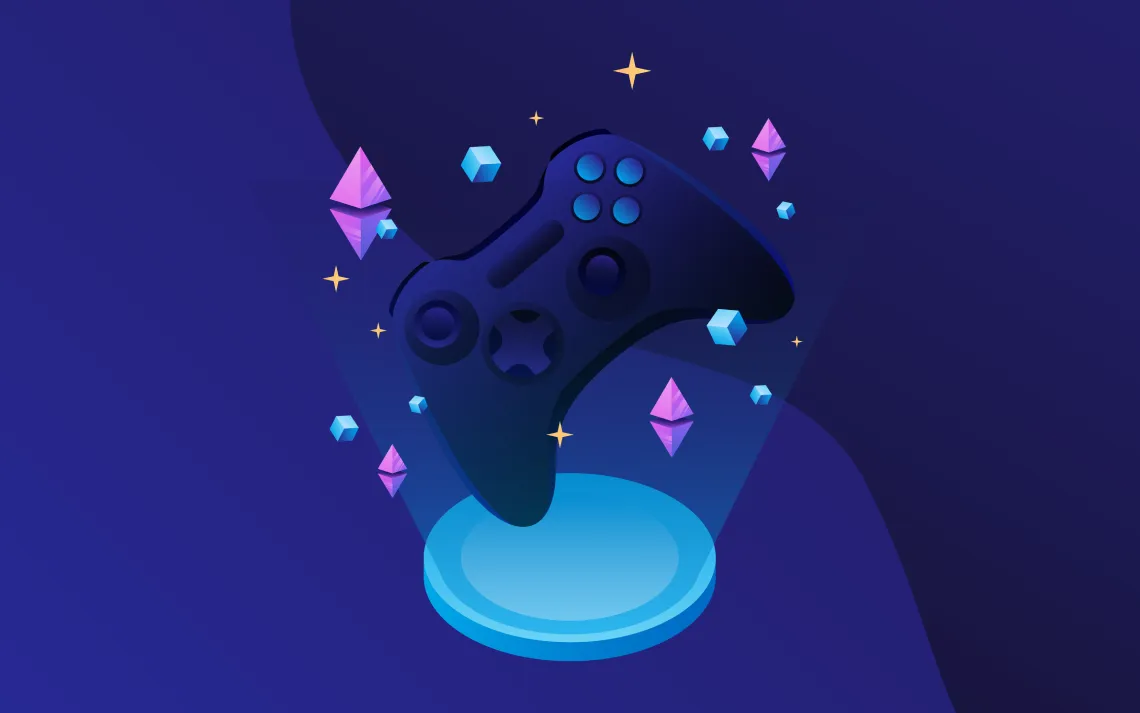In a bold move signaling a significant shift in the global gaming industry, Asia has emerged as a powerhouse in blockchain gaming, committing billions of dollars to the development and expansion of this innovative sector. With a commanding 55% dominance, Asian investors are spearheading the adoption of blockchain technology in gaming, leveraging its transformative potential to revolutionize gameplay, ownership, and monetization structures.
This strategic investment not only underscores Asia's determination to lead the digital entertainment landscape but also heralds a new era where blockchain stands poised to redefine the very foundations of gaming as we know it. In this article, we will cover the latest data reported by DappRadar and Pacific Meta on the state of blockchain gaming in Asia.

Key Takeaways
- Blockchain gaming comprises 35% of the total dapp industry’s activity, with approximately 2.2 million daily Unique Active Wallets.
- 35% of traffic to DappRadar game rankings originates from Asia, highlighting the region’s significant interest in this sector.
- Pixels is the most popular game per DappRadar, drawing 20% of its traffic from the Philippines and 48.6% from Asia.
- Among DappRadar's top 10 boosted dapps, half are gaming dapps developed by Asian studios, reflecting Asia’s key role in the sector and the support and contributions from their communities.
- The metaverse and blockchain gaming sectors have received $14.6 billion in investments since 2019, with 55% involved from Asian VCs and firms like Animoca Brands.
- Pacific Meta’s survey shows a 68% increase in blockchain gaming engagement since their April 2023 survey, with 10.6% of respondents having played a blockchain game.
- 72.9% of Pacific Meta survey respondents began their blockchain gaming experience within the past year, indicating a surge of new market entrants despite the crypto winter.

Asia Invests Billions in Web
In the rapidly growing landscape of web3 gaming, Asia is positioned as a leader, driving global adoption through innovative blockchain gaming initiatives. Currently, this vibrant sector captures 35% of global blockchain activity.
Countries like China are preparing their vast player base, comprising 700 million individuals, for the shift towards blockchain-enabled gaming experiences. With prominent gaming enterprises originating from China, Japan, and South Korea, Asia serves as the central hub for the worldwide expansion of web3 gaming. This emphasizes the region's pivotal contribution to shaping the future digital gaming terrain.
(1) Web3 Gaming Traffic
(a) Dapps UAW Per Catagory
During the initial quarter of 2024, DappRadar recorded approximately 2.2 million daily Unique Active Wallets (dUAW) engaging with gaming decentralized applications (dapps). This statistic highlights blockchain gaming's significant share, comprising 35% of total dapp industry engagement. This data firmly establishes blockchain gaming as the foremost category within the dapp ecosystem.
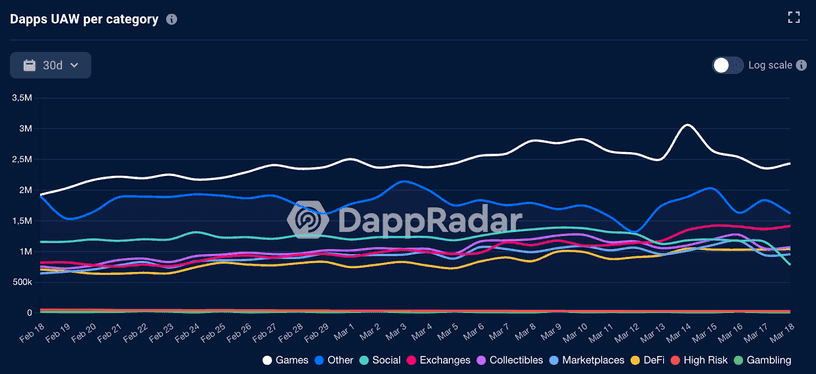
(b) Device Breakdown
Upon diving deeper into the geographic data distribution based on the game rankings analysis from DappRadar, it is revealed that 32% of the audience comes from Asia. In terms of device usage, there exists a split of 62% on desktop and 38% on mobile platforms.
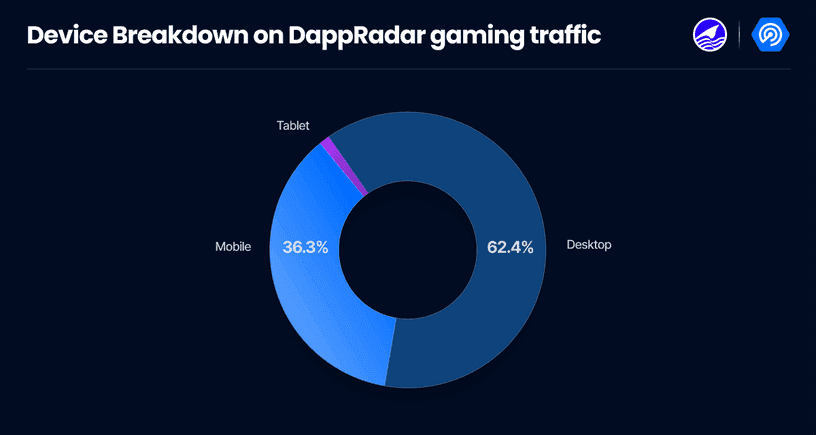
(c) User Acquisition Weight (UAW)
It's noteworthy that numerous gaming projects prioritize making their games accessible across multiple devices. To overcome distribution constraints imposed by platforms like Apple or Google, they often develop browser-based games or Progressive Web Apps (PWAs). Despite observing substantial traffic originating from desktop devices, development teams allocate significant resources to crafting immersive mobile experiences.
Below, we dive further into game rankings to pinpoint the most popular games based on User Acquisition Weight (UAW). Additionally, we'll examine the sources of their traffic to illuminate several noteworthy insights.

(d) Top Performing Games
Pixels has emerged as a prominent game, garnering significant attention, particularly with 20% of its traffic stemming from the Philippines, a country pivotal to the rise of Axie Infinity, and 8.4% from the United States. Notably, aggregate traffic from Asian countries to Pixels constitutes 48.6%.
Matr1x has secured the second position, recently gaining traction among web3 enthusiasts. Notably, 39% of its user activity originates from Asian countries. Matr1x uniquely blends social networking and gaming elements, offering users a futuristic cyberpunk world experience through episodic games.

StarryNift, positioned third, is celebrated as a co-creative metaverse platform that enriches the play, create, and socialize experience with a 3D virtual environment. Notably, it enjoys a significant 38% of its user activity from Asian countries, as indicated by DappRadar’s traffic data.
MotoDEX and Sweat Economy, two prominent gaming platforms, demonstrate significant engagement from Asian markets, comprising 36% and 30% of their user base, respectively. Notably, the United States constitutes the largest portion of traffic for both applications.

(e) Top 10 Boosted Dapps
In a bid to gain insights into community engagement and gamer behavior, an analysis was conducted on the top 10 boosted dapps from the preceding three months. Boosting involves users staking RADAR to acquire Boosting Power, which they can allocate to their preferred projects. This process enhances the visibility of selected projects on the DappRadar platform, thereby increasing their potential user base.
Of the highlighted dapps, five are categorized under gaming, each supported by gaming studios or teams hailing from Asian countries. These gaming ventures have showcased an impressive capacity to engage expansive communities through the boosting system, underscoring the crucial role of community backing in web3.
The extensive timeframe typically required for developing a successful game underscores the indispensable contribution of the community throughout the journey. This recognition accentuates the significance of pinpointing gaming dapps with the most vibrant and engaged communities on the platform, highlighting that the robustness of these communities often plays a pivotal role in a game's triumph within the web3 landscape.
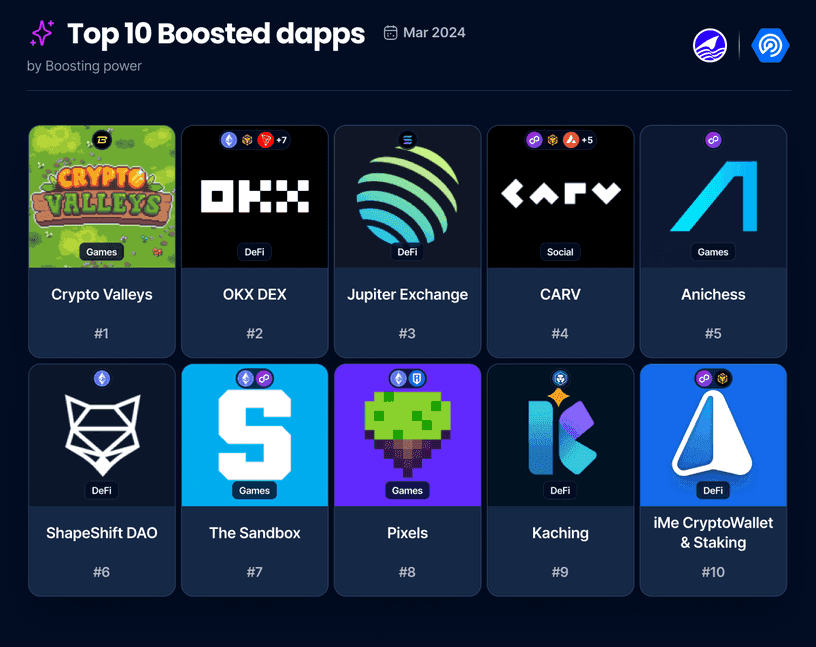
(2) Asia Blockchain Gaming Market
In 2023, the global gaming industry demonstrated its significant influence, generating an estimated revenue of $187.7 billion and boasting a player base of approximately 3.38 billion worldwide, according to data from Newzoo.
(a) Asia Makes Up 53% of Total Global Gamers
In terms of users, the global gaming community is set to expand to 3.38 billion individuals, marking a 6.3% increase from the previous year. The majority, 53%, is concentrated in the Asia-Pacific region, with notable growth in the Middle East and Africa at 12.3% per year. The number of paying gamers is projected to grow by 7.3% to 1.47 billion, with an expected annual growth rate of 4.7% leading to 1.66 billion paying gamers by the end of 2026.

(b) Asia Makes Up 46% of Total Global Revenue
The geographical landscape of gaming revenue is equally fascinating. The Asia-Pacific region dominates, comprising 46% of the total revenue, followed by North America at 27%, Europe at 18%, Latin America at 5%, and the Middle East and Africa at 4%. The MENA region emerges as the fastest-growing, exhibiting a remarkable 6.9% annual growth rate.
However, Korea stands as a powerhouse in global mobile gaming, with the market experiencing a remarkable surge in revenue. According to recent data from Sensor Tower, mobile game in-app purchase revenue in the Korean market is anticipated to reach nearly $3.6 billion, with overseas manufacturers claiming over 40% of this lucrative sector.

(c) Mobile Gaming Makes Up $92.6 Billion
The gaming market is slated to surge to $187.7 billion, a 2.6% increase from the previous year. Diverse revenue streams contribute to this staggering figure, with mobile gaming leading at $92.6 billion, closely followed by the console market, which experienced an impressive 7.4% growth, reaching $56.1 billion. The PC segment shows resilience with $37.1 billion in revenue, overcoming the decline in browser PC games.

(d) Asia and Blockchain Gaming
Asia, renowned for its vibrant cultures and technological innovation, leads the global gaming landscape by contributing 46% of the total gaming revenues. Despite encountering slower growth compared to other regions, primarily due to regulatory challenges in China, Asia remains a dominant force, making substantial contributions to the global gaming economy.
The region's progressive stance towards blockchain and web3 technologies further cements its position, signaling the advent of a new gaming era characterized by decentralized, player-centric ecosystems.
Unlike the Western markets where blockchain technologies often face skepticism, Asia's gaming industry demonstrates a more receptive attitude, leading to increased development activities and higher player engagement. This enthusiasm for blockchain gaming underscores the region's technological adaptability and its eagerness to spearhead the evolution of gaming.

Prominent gaming publishers in Asia, such as Sega and Square Enix, are increasingly exploring blockchain gaming, recognizing its potential to redefine player ownership, game economics, and digital interactions within gaming realms. This transition towards blockchain gaming is supported by a combination of cultural openness, technological prowess, and strategic government policies aimed at nurturing innovation and expansion in the sector.
Since 2019, the metaverse and blockchain gaming sectors have attracted significant investments, totaling $14.6 billion, with approximately 55% originating from Asian venture capitalists and prominent entities like Animoca Brands and Binance Labs. Japan emerges as a pivotal hub for the growth of web3 gaming, leveraging its rich gaming heritage and technological leadership.
The country's advanced gaming ecosystem, bolstered by a sophisticated regulatory framework and a culture that values gaming as a form of entertainment and expression, provides an ideal landscape for the proliferation of blockchain-based gaming ventures. Homegrown blockchain-powered ecosystems like Oasys and Astar Network are poised to elevate blockchain gaming to unprecedented levels in the region.

(3) Japan’s Web3 Gaming Evolution
Established in August 2022, Pacific Meta Inc. has distinguished itself by providing specialized advisory and marketing services tailored to meet the unique needs of international web3 projects seeking to penetrate the Japanese and East Asian markets.
Recognizing the growing interest and knowledge gap in blockchain gaming within Japan, Pacific Meta conducted a survey this March 2024. This survey engaged 1,359 individuals across a wide age spectrum, ranging from their 20s to their 70s, to gain insights into this dynamic sector.
Building upon its initial exploration in April 2023, the March 2024 survey by Pacific Meta serves as a continuation, aiming to deepen the understanding of Japan's landscape regarding blockchain gaming. The survey's results present a comprehensive array of data, offering valuable insights into evolving player behaviors and preferences.
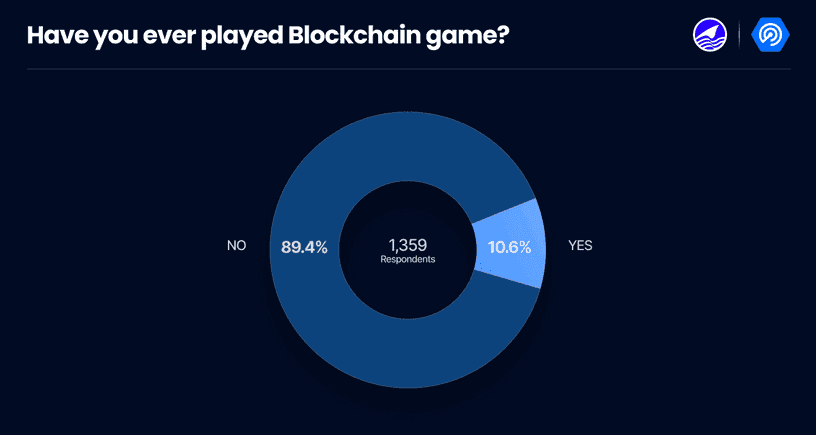
An evident surge in participation in blockchain gaming has been noted, with a remarkable 68% increase in individuals who have engaged in blockchain games since Pacific Meta's previous survey. This uptick highlights a growing curiosity and acceptance of blockchain technology in gaming among the Japanese population.
Of significance is the observation that the blockchain games gaining momentum are those that resonate strongly with Japanese culture. For instance, SingSing on Oasys introduces a karaoke-themed game, a concept deeply rooted in Japanese culture and appealing to its audience.
Similarly, Double Jump Tokyo and SEGA's Battle of Three Kingdoms immerses players in a narrative rich with historical context, reflecting the profound historical interest ingrained in Japanese gaming tradition.
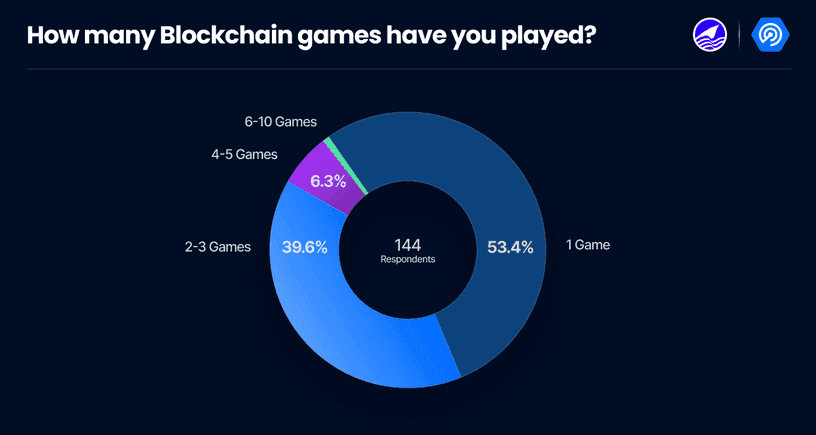
The data indicates a discernible trend among Japanese players, showing a preference for more immersive engagement with a select few blockchain games rather than superficial involvement across many titles. This inclination towards depth over breadth signifies a desire for meaningful gaming experiences among the Japanese gaming community.
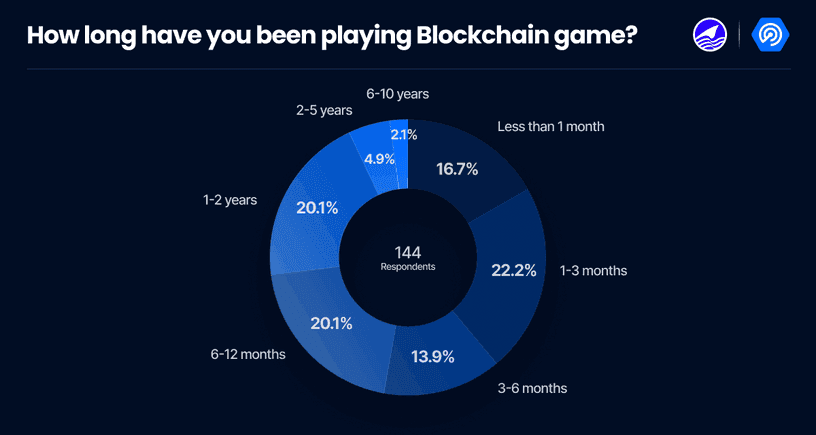
An impressive 72.9% of respondents indicated that they commenced their blockchain gaming journey within the last year, signaling a substantial influx of new participants into the market despite the challenges posed by the prolonged period of crypto winter.
This surge coincides with the emergence of gaming chains, Layer-2 scaling solutions, and the introduction of playable games such as Pixels, various Axie titles, as well as mobile games like Nine Chronicles and Gods Unchained. These developments are intertwined with the observed trend, underlining the evolving landscape of blockchain gaming and its increasing appeal to newcomers.
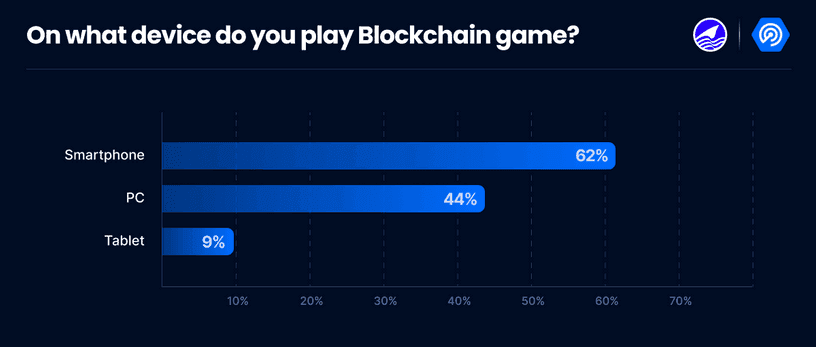
Considering the broader gaming ecosystem, the "Famitsu Game White Paper 2022" sheds light on the prevalence of app game users in Japan. With the emergence of blockchain gaming, there is an anticipated transition towards web3 gaming, which has the potential to expand the demographic of mobile gamers, given their current dominance in the gaming landscape.
This projected shift suggests a significant evolution in gaming preferences and behaviors, with web3 gaming poised to reshape the gaming industry's landscape in Japan and beyond.
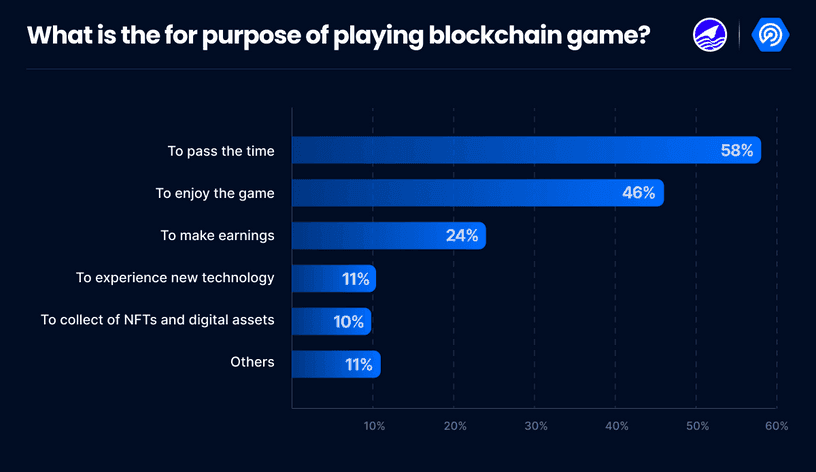
A majority of respondents cited leisure and time-passing as their primary motivations for gaming, surpassing the pursuit of enjoyment or financial gain. This trend is likely facilitated by the ubiquity and convenience of smartphones, which serve as the preferred platform for engaging with blockchain games.
Moreover, it's essential to recognize that blockchain-powered games should be viewed primarily as entertainment, rather than as a means of full-time employment. This perspective underscores the importance of maintaining a balance between gaming for leisure and other aspects of life.
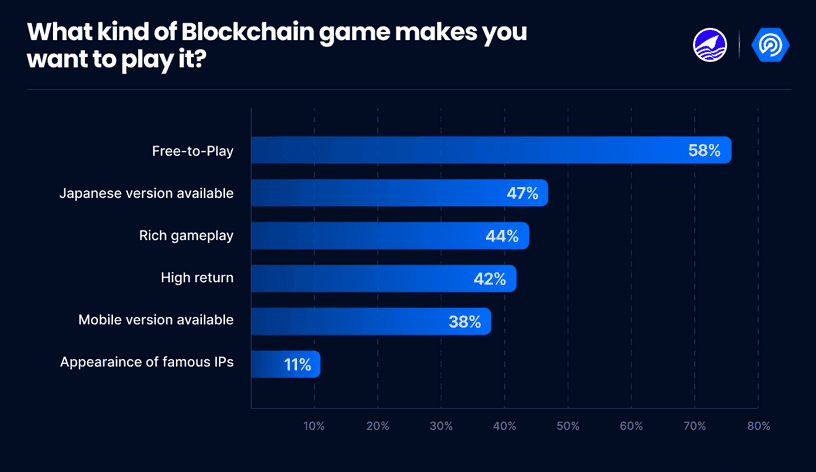
Free-to-Play models have emerged as a significant strategy for attracting players to blockchain gaming, with language accessibility and gameplay quality also rated highly by respondents.
These preferences underscore the challenges faced by non-Japanese speaking games in a market sensitive to language barriers, reflecting Japan's relatively lower English proficiency. Moreover, it emphasizes the importance of streamlining the onboarding process for new players, allowing gamers to download and play a game without the complexities of purchasing NFTs or connecting wallets.
Social media platforms, Japanese web media, blogs, and personal networks were identified as the primary channels through which players discover blockchain games. The prominence of social media is particularly notable for its role in connecting players with Japanese Key Opinion Leaders (KOLs) and for the increasing efforts by foreign blockchain game projects to establish a presence on Japanese social platforms. This highlights the significance of leveraging various channels to reach and engage with the Japanese gaming audience effectively.
Final Thoughts
The data provided by DappRadar and Pacific Meta paint a compelling picture of Asia's pivotal role in driving the momentum of blockchain gaming. Accounting for 35% of the total dapp industry's activity and with a staggering 2.2 million daily Unique Active Wallets, the region's enthusiasm for this innovative sector is unmistakable.
Notably, 35% of DappRadar game rankings traffic originates from Asia, underlining the region's profound interest in blockchain gaming. Pixels emerges as a standout title, with a significant portion of its traffic hailing from the Philippines and Asia at large.
Moreover, half of DappRadar's top 10 boosted dapps are gaming applications from Asian studios, underscoring both the region's dominance in the sector and the fervent support from their communities. This fervor is further evidenced by the $14.6 billion investments poured into the metaverse and blockchain gaming sectors since 2019, with a substantial 55% contribution from Asian VCs and firms like Animoca Brands.
Pacific Meta's survey findings reinforce this narrative, revealing a remarkable 68% increase in blockchain gaming engagement since April 2023, with 10.6% of respondents having played a blockchain game. Perhaps most strikingly, 72.9% of Pacific Meta survey respondents embarked on their blockchain gaming journey within the past year, signaling a surge of new market entrants despite prevailing market conditions.
These statistics not only underscore Asia's prominence in shaping the future of gaming but also point towards a burgeoning ecosystem ripe with innovation and opportunity, poised to redefine the very fabric of interactive entertainment on a global scale. This article was inspired by an original blog post, you can read the original write-up here for more information.







